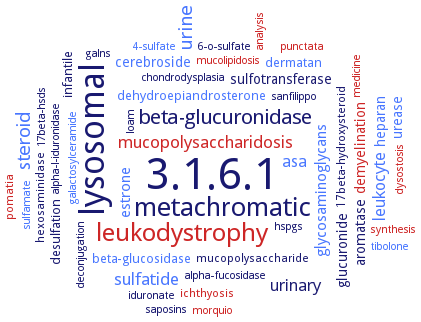3.1.6.1: arylsulfatase (type I)
This is an abbreviated version!
For detailed information about arylsulfatase (type I), go to the full flat file.

Word Map on EC 3.1.6.1 
-
3.1.6.1
-
lysosomal
-
metachromatic
-
leukodystrophy
-
beta-glucuronidase
-
steroid
-
urine
-
mucopolysaccharidosis
-
sulfatide
-
leukocyte
-
urinary
-
asa
-
estrone
-
glycosaminoglycans
-
glucuronide
-
demyelination
-
cerebroside
-
urease
-
sulfotransferase
-
aromatase
-
heparan
-
beta-glucosidase
-
desulfation
-
dehydroepiandrosterone
-
dermatan
-
infantile
-
17beta-hydroxysteroid
-
mucopolysaccharide
-
pomatia
-
ichthyosis
-
hexosaminidase
-
morquio
-
saposins
-
iduronate
-
17beta-hsds
-
galactosylceramide
-
alpha-fucosidase
-
chondrodysplasia
-
hspgs
-
synthesis
-
medicine
-
deconjugation
-
analysis
-
6-o-sulfate
-
tibolone
-
alpha-l-iduronidase
-
loam
-
sanfilippo
-
galns
-
punctata
-
mucolipidosis
-
sulfamate
-
4-sulfate
-
dysostosis
- 3.1.6.1
- lysosomal
-
metachromatic
- leukodystrophy
- beta-glucuronidase
- steroid
- urine
- mucopolysaccharidosis
- sulfatide
- leukocyte
- urinary
- asa
- estrone
- glycosaminoglycans
-
glucuronide
- demyelination
- cerebroside
- urease
-
sulfotransferase
- aromatase
- heparan
- beta-glucosidase
-
desulfation
- dehydroepiandrosterone
- dermatan
-
infantile
-
17beta-hydroxysteroid
-
mucopolysaccharide
- pomatia
- ichthyosis
- hexosaminidase
- morquio
-
saposins
-
iduronate
- 17beta-hsds
- galactosylceramide
- alpha-fucosidase
-
chondrodysplasia
-
hspgs
- synthesis
- medicine
-
deconjugation
- analysis
-
6-o-sulfate
- tibolone
- alpha-l-iduronidase
-
loam
-
sanfilippo
- galns
- punctata
- mucolipidosis
- sulfamate
- 4-sulfate
- dysostosis
Reaction
Synonyms
4-methylumbelliferyl sulfatase, ARS, ARS-A, ARS-B, ARSA, ARSB, ARSE, ARSK, ary 423, Aryl-sulfate sulphohydrolase, arylsufatase B, arylsulfatase, arylsulfatase A, arylsulfatase B, arylsulfatase E, arylsulfatase Es-2, arylsulfatase G, arylsulfatase gene, arylsulfatase III, arylsulfatase J, arylsulfatase K, arylsulfatase type VI, arylsulfate sulfohydrolase II, arylsulfohydrolase, arylsulphatase, arylsulphatase A, AS-A, ASG, AstA, AtsA, estrogen sulfatase, KIAA1001, nitrocatechol sulfatase, p-nitrophenyl sulfatase, P70, PAS, phenolsulfatase, phenylsulfatase, sulfatase, sulfatase, aryl-
ECTree
Advanced search results
Engineering
Engineering on EC 3.1.6.1 - arylsulfatase (type I)
Please wait a moment until all data is loaded. This message will disappear when all data is loaded.
C80A
about 20% of wild-type activity at neutral pH, about 5% of wild-type activity at pH optimum
G137A
-
the mutation is associated with X-linked recessive chondrodysplasia punctata
I40S
-
the mutation is associated with X-linked recessive chondrodysplasia punctata
N350S
mutant exhibits a consistent degree of unfolding, which may be related to its in vitro reduced stability
P578S
-
the mutation is associated with X-linked recessive chondrodysplasia punctata
T409M
-
the mutation is associated with X-linked recessive chondrodysplasia punctata
W124G
-
naturally occurring missense mutation causing ARSA deficiency, isolated from two Tunisian patients with late infantile metachromatic leukodystrophy, MLD
N497Q
mutation of glycosylation site N497 abrogates transport to lysosomes, due to impaired mannose 6-phosphate modification
H260L
mutant displays increased thermostability and increased half-life at 55°C
K253H/H260L
7.7fold increase in half-life compared to wild-type
additional information
-
intracerebral injection of a serotype 5 adeno-associated vector, AAV2-5, encoding human ARSA in ARSA-deficient mice corrects the biochemical, neuropathological and behavioral abnormalities. Injection in the right hemisphere and into three selected areas of the centrum semiovale white matter, or in the deep gray matter nuclei, caudate nucleus, putamen, thalamus, of six non-human primates, Macaca fascicularis, to evaluate vector distribution, as well as expression and activity of human ARSA, overview. ARSA enzyme is expressed in multiple interconnected brain areas and ARSA activity is increased by 12-38% in a brain volume that corresponded to 5065% of injected hemisphere
additional information
-
sperm of enzyme deficient mice shows a significant delay in dispoersion of expanded cumulus oocyte complexes. Within 1 h of sperm-cumulus oocyte complex co-incubation, the size of cumulus oocyte complexes incubated with enzyme deficient sperm is 65% of its original dimension, whereas that of cumulus oocyte complexes inseminated with wild-type sperm is only 17%


 results (
results ( results (
results ( top
top






